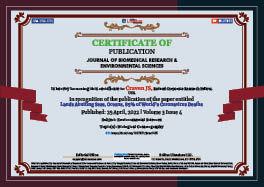Craven JS*
Volume3-Issue4
Dates: Received: 2022-04-16 | Accepted: 2022-04-23 | Published: 2022-04-25
Pages: 397-405
Abstract
The Worldometer Coronavirus registered six million deaths on March 03, 2022. 85% of the deaths occurred in lands directly abutting the World Seas and Oceans. The WHO, CDC and other World Public Health Organizations suggest that humidity can aid in the fight against COVID-19 [1]. The boundary of this comment is that it is directed at indoor air quality with perspective that 40-60% humidity is positive against COVID-19. The fact that almost all the World COVID-19 deaths are in lands directly abutting the Major World Seas and Oceans, with their inherent natural humidity, does not seem to be addressed in technical literature. There seems to be a conflict. This paper provides a breakdown of the World’s deadliest coronavirus regions at the six million death milestone, compares it to the earlier evaluation by the author captured in a WordPress website [2-10], and provides an in depth breakdown of the pandemic deaths and death rates in the lands abutting the Major World Seas and Oceans. Maps are provided showing the surrounding Countries or States of Countries with death and death rate tables for each of the World’s Major bodies of water. These are startling in similarity.
FullText HTML
FullText PDF
DOI: 10.37871/jbres1455
Certificate of Publication

Copyright
© 2022 Craven JS. Distributed under Creative Commons CC-BY 4.0
How to cite this article
Craven JS. Lands Abutting Seas, Oceans, 85% of World’s Coronavirus Deaths. J Biomed Res Environ Sci. 2022 Apr 25; 3(4): 397-405. doi: 10.37871/jbres1455, Article ID: JBRES1455, Available at: https://www.jelsciences.com/articles/jbres1455.pdf
Subject area(s)
References
- Joseph A, Chan Harvard TH. OP-ED: Humidity can aid in the fight against Covid-19. School of Public Health. 2020 November 18.
- Craven JS. World’s Coronavirus Death Regions & Why, Part 1 – recognition that world regions independently experienced coronavirus deaths in identifiable patterns, principally impacted by major pollution sources and exasperated by seasonal temperature inversions. WordPress.com. 2021. doi: 10.17352/acmph.
- Craven JS. World’s Coronavirus Death Regions & Why, Part 2 – Considered differences of Western World vs Eastern World do to wide difference in deaths. WordPress.com. 2021.
- Craven JS. World’s Coronavirus Death Regions & Why, Part 3 – Recognized that majority of deaths were occurring in humid sub-tropical climates. WordPress.com.
- Craven JS. World’s Coronavirus Death Regions & Why, Part 4 - With abrupt increase in South American deaths, focused on role of pesticides on creating deaths. WordPress.com. 2021.
- Craven JS. World’s Coronavirus Death Regions & Why, Part 5 - Evaluated whether other world regions were similar in characteristics as their deaths increased to those in Parts 1 through 4. WordPress.com.
- Craven JS. World’s Coronavirus Death Regions & Why, Part 6 - Realized that coronavirus deaths regions were being controlled by the world’s jet streams. WordPress.com. 2021.
- Craven JS. World’s Coronavirus Death Regions & Why, Part 7 - Updated world coronavirus death statistics for the predominant deadly regions. WordPress.com. 2021.
- Craven JS. World’s Coronavirus Death Regions & Why, Part 8 - Realized that the world’s largest brackish Seas, encompassing major pollution sources, accounted for 55% of world’s coronavirus deaths. WordPress.com. 2021.
- Craven JS. World’s Coronavirus Death Regions & Why, Part 9 - Extended evaluation to world’s brackish Oceans to findings for brackish Seas, accounting for 85% of world’s coronavirus deaths. WordPress.com. 2021.
- Craven JS. World’s Coronavirus Death Regions & Why, Part 11, Influence of sub-micron and nano-sized pollutant particles on the Transmission of Coronavirus Over Long Distances. Wordpress.Com. 2021.
- Wang CC, Prather KA, Sznitman J, Jimenez JL, Lakdawala SS, Tufekci Z, Marr LC. Airborne transmission of respiratory viruses. Science. 2021 Aug 27;373(6558):eabd9149. doi: 10.1126/science.abd9149. PMID: 34446582; PMCID: PMC8721651.
- Ren SY, Wang WB, Hao YG, Zhang HR, Wang ZC, Chen YL, Gao RD. Stability and infectivity of coronaviruses in inanimate environments. World J Clin Cases. 2020 Apr 26; 8(8):1391-1399. doi: 10.12998/wjcc.v8.i8.1391. PMID: 32368532; PMCID: PMC7190947.
- Comunian S, Dongo D, Milani C, Palestini P. Air Pollution and Covid-19: The Role of Particulate Matter in the Spread and Increase of Covid-19's Morbidity and Mortality. Int J Environ Res Public Health. 2020 Jun 22;17(12):4487. doi: 10.3390/ijerph17124487. PMID: 32580440; PMCID: PMC7345938.
- Khorsandi B, Farzad K, Tahriri H, Maknoon R. Association between short-term exposure to air pollution and COVID-19 hospital admission/mortality during warm seasons. Environ Monit Assess. 2021 Jun 18;193(7):426. doi: 10.1007/s10661-021-09210-y. PMID: 34142254; PMCID: PMC8211536.
- Keikhosravi G, Fadavi SF. Impact of the inversion and air pollution on the number of patients with Covid-19 in the metropolitan city of Tehran. Urban Clim. 2021 May;37:100867. doi: 10.1016/j.uclim.2021.100867. Epub 2021 May 1. PMID: 33968607; PMCID: PMC8088236.
- Jianlei L, Shengyue L, Shuiyuan C, Ying Z, Dongsheng C, Yanyun Z, Hanyu Z, Haiyan W. Chemical characteristics and sources of submicron particles in a city with heavy pollution in China, Key Laboratory of Beijing on Regional Air Pollution Control, College of Environmental & Energy Engineering. Beijing University of Technology. 2018; 9(10):388. doi: 10.3390/atmos9100388.
- Pollution from nanomaterials, Wikipedia, Part of a series of articles on the Impact of nanotechnology Health and safety, Nanotechnologies » Level 3 » Question 5 Nanotechnologies home Source document: SCENIHR (2006), Summary & Details: GreenFacts (2007) About Nanotechnologies.
- Smedley T. The toxic killers in our air too small to see. Bloomsbury. November 15, 2019.
- Craven JS. World’s Coronavirus Death Regions & Why, East-Central Europe – World’s Deadliest Coronavirus Region. WordPress.com. 2022. doi: 10.17352/2455-5479.000171.
- Mary AC, French HF. Restoring the Eastern European and Soviet Environments, In State of the World 1991, New York: Norton. Eastern European Pollution. 1991.